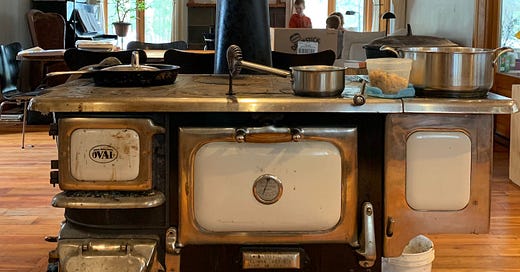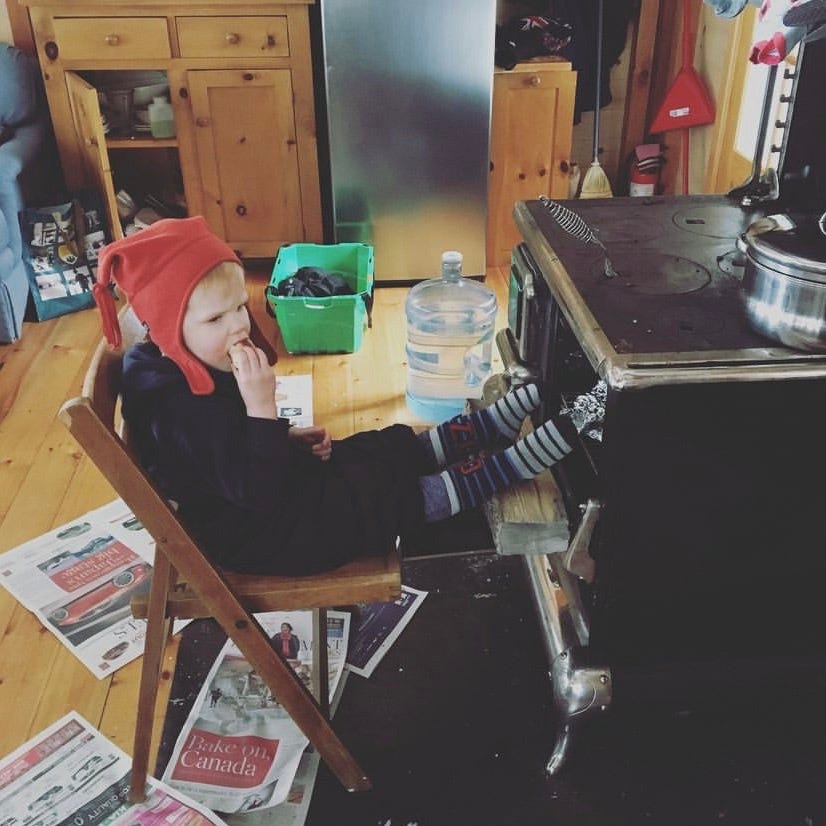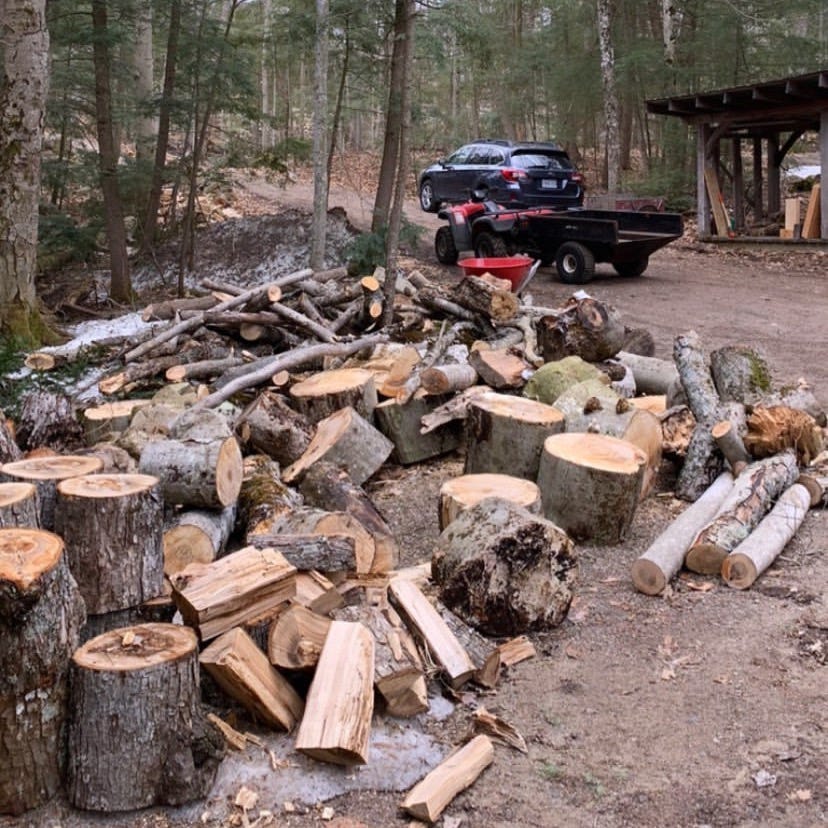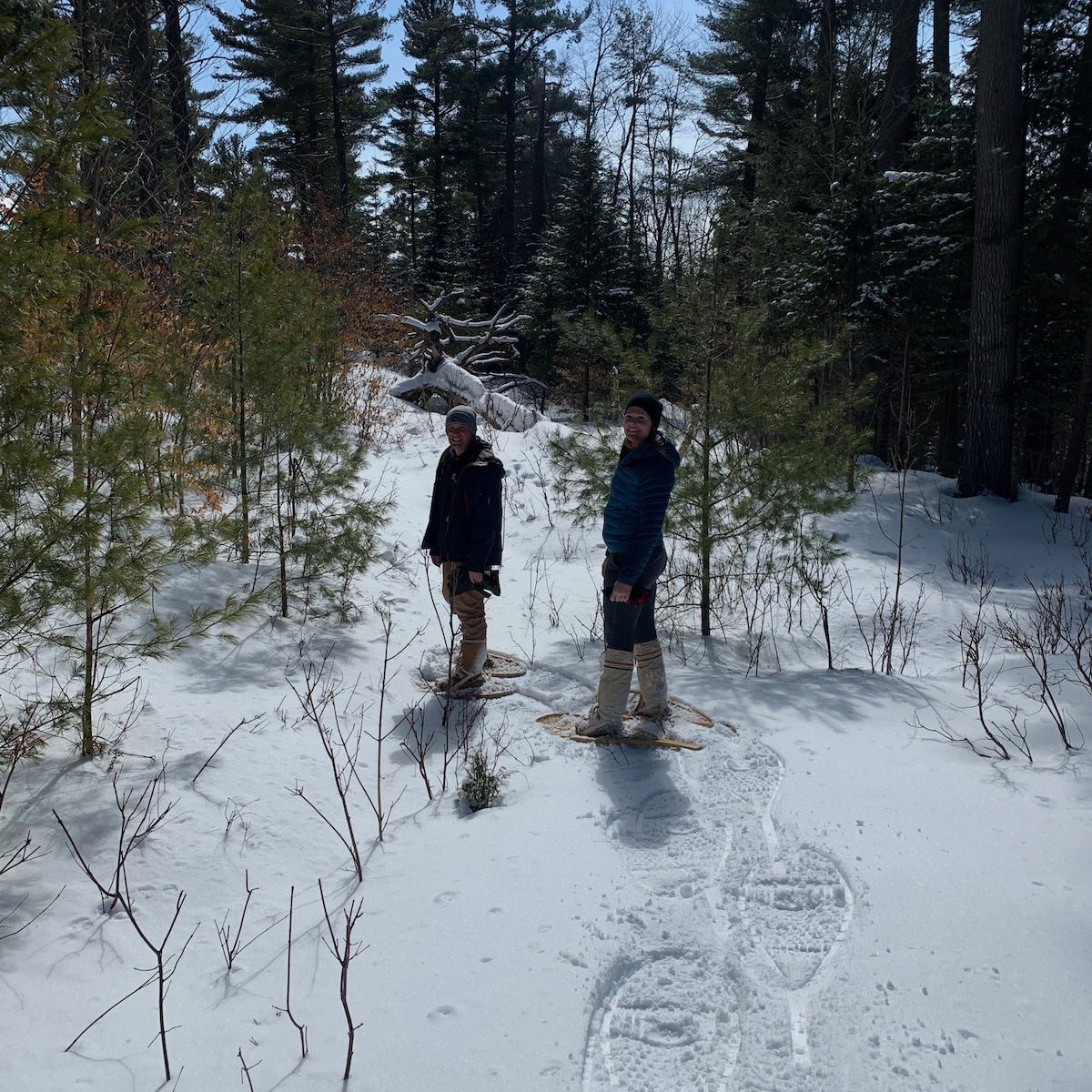Meet Raven, Purveyor of Warmth
This wood-burning cookstove heats my parents' home (and everyone's hearts).
A big cast iron cookstove sits in the middle of my parents' kitchen. It dominates the room, separating the cooking and eating areas and emanating relentless warmth during the winter months.
My mom named it Raven years ago. It's not uncommon to hear her say things like, "Raven needs another log!" or "Put your wet socks under Raven," or "Someone stir the beans on Raven." But the naming of inanimate objects has never really caught on for me, and I usually don't refer to the stove by any name. What has stuck, however, is this weird and admittedly illogical idea that the stove is somehow part of our family, a living entity of sorts.
When the stove is operating, it becomes a magnetic force in the home that attracts anyone who enters. Newcomers approach it in amazement, commenting on its size and heat output. People stand around, warming their hands above the hot surface or pulling up chairs to thaw out their feet. The slate floor below is always strewn with damp boot liners and snow-crusted mittens that quickly evaporate and turn toasty warm; it's quite lovely to put them on, preheated, when venturing back outside.
This is Raven’s little sister, located in my parents’ off-grid cabin. But this photo demonstrates the multifunctional capacities of such a stove, including a built-in foot warmer, aka a log propped up on the oven door.
Mixed Emotions
I have a love-hate relationship with this stove. It seems like such a labor-intensive and archaic way to heat a home. It has an insatiable appetite for wood. Building fires in the deep, narrow box is tricky. It requires shorter logs that we separate out manually from the furnace logs when stacking firewood to dry in the summer. My dad insists on this: one side of the woodshed is dedicated to Raven's future needs.
You have to know what you're doing when you light the fire. Dampers need to be open so the kitchen doesn't fill with smoke. You must use the right kindling and logs. Once the fire is established, you can reduce the airflow and gradually close the dampers to capture more heat. All of this requires constant monitoring, tweaking, and adjusting; you can't leave the room for too long or else the fire might die—or, worse yet, start billowing black smoke. That's a bad time for everyone.
The rest of the house remains frigid until the stove finally starts pumping out its heat. But even then, the heat does not diffuse throughout the house the way a forced air system does. Rather, it creates zones that range from too hot to not hot enough. The downstairs eventually becomes uncomfortably hot, while the upstairs remains too cool.
There’s good reason why, years ago, I wrote an article called, “I Grew Up in a House That Looked Like a Hygge Postcard, and It Was a Lot of Work.” I still maintain that stance.
Chore time!
And yet…
I love that stove. It works for us in so many real, tangible ways—hence my earlier reference to it feeling like a family member. Apart from drying outerwear, we can set up racks of laundry that dry in less time than a machine cycle would take. There's a rack above the stove where we hang frying pans and cooking implements to dry. There are always pots of stock, beans, ham, or water simmering on top, and you can control the cooking level by moving the pot further away from the heat source. It's like cooking with passive energy: it's already there, so why not put it to multiple uses?
There is something to be said for the fact that the stove is fuelled by wood that is logged, split, and dried just mere kilometres from the house. It's not perfect—I do fret about air quality and am convinced my dad's lifelong asthma has been worsened by decades of lighting daily fires—but there are no controversial pipelines or refineries needed for this source of energy. It's about as local as it gets.
As I write this, the power has gone out (as it frequently does in this part of the country). The house is being pummelled by freezing rain, but the cookstove's presence means that nothing really changes in the rhythm of the day. We're still warm and cozy; the kids' snow gear will be dry within an hour. The soup I made for lunch continues to simmer on top, and the cookie dough I just mixed up will get baked in the cookstove's oven.
At times like these, I feel grateful for this old-fashioned technology that offers such practical comfort. We tend to be so quick to throw away older ways of doing things in favour of newer, simpler, more exciting, and more technologically advanced methods without asking ourselves, "What do we lose in the process?" Social critic Neil Postman referred to this as "technological immodesty," when people are so quick to allow technology to redefine every aspect of a culture that they become "[insensitive] to what skills may be lost in the acquisition of new ones."
In the case of this cookstove, if it were to be replaced with a smart thermostat, my fire-lighting skills would deteriorate—and that's something I'm rather proud of! When visiting my parents, I'd have to rely on other devices and machines to do things like dry clothes, dishes, and cook food. I'd have to take a hot shower or bath to warm up after a long snowshoe instead of sitting by the stove.
My kids wouldn't learn how to navigate the stove with care, one of the first lessons I taught them as babies. They wouldn't know what it's like to be sent out in a snowstorm to restock the woodbox, hauling logs in a wheelbarrow and stacking them neatly. They wouldn't learn how to split kindling with a hatchet. At risk of sounding like a Luddite, I do sometimes worry that there are so few opportunities for life-sustaining physical labor in my children's lives, but maintaining that ravenous cookstove for several months each year is one small task that provides that satisfaction.
We tend to be so quick to throw away older ways of doing things in favour of newer, simpler, more exciting, and more technologically advanced methods without asking ourselves, "What do we lose in the process?"
I'm not about to install a wood-burning cookstove in my own home. That is far too much work, and it doesn't make sense in an urban setting. But I can appreciate it when I visit my parents, at their home deep in the forest, on the edge of a northern Ontario lake. Seeing Raven in all her hot, shimmering glory reminds me that, no matter what fancy gadgets we humans may have developed, our needs have not evolved much beyond those of our great-grandparents and beyond. On a base level, staying warm and fed is still really all we need, and that stalwart, antiquated cookstove does the job reliably, no matter the weather outside. For that I am grateful.








I love it. It's a wonderful article. Your mom's stove is amazing. The visuals remind me of my grandparents house in the woods. A house they built themselves. They had a potbelly wood stove in the basement and a large space heater in a small hallway just outside the kitchen. The bedrooms upstairs would be chilly and my grandmother would constantly yell at my grandfather to turn up the heat and put wood in the stove. Looking at that woodpile outside the cabin is also a reminder of how difficult it becomes to maintain a property as you age and slow down. Time passes so fast.
I'm new to finding your work, and am so very grateful for it in this phase of life.
This piece in particular speaks to my spirit. My husband and I are moving into a yurt with our two babes this week and will be heating and cooking with a wood cookstove. These are the memories we hope to give our children, and someday, their children. We are continuously becoming more "analog," and I hope as adults they can find the meaning in our kookiness, and that our own grandkids can benefit from what we teach and value.
I grew up with woodstove heat, and though my mom is the microwave queen and we moved from that house to town when I was 13, that woodstove paints and warms my fondest childhood memories...like sitting in front of it wrapped in my towel after a bath to dry off. To this day, I smell people who have woodstove heat in their homes, and it is the most romantic and nostalgic scent.
Thank you for sharing.